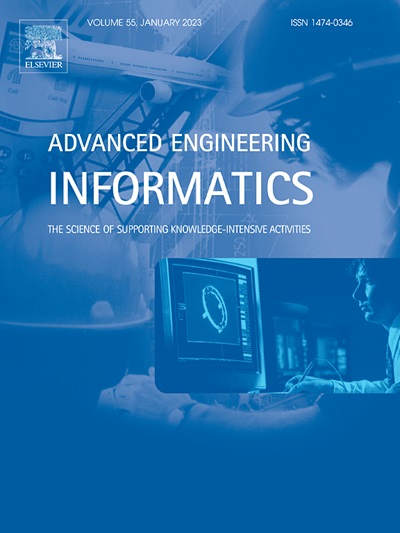构建中的语义数字孪生:基于信息容器的模块化系统参考体系结构的开发
IF 9.9
1区 工程技术
Q1 COMPUTER SCIENCE, ARTIFICIAL INTELLIGENCE
引用次数: 0
摘要
建筑业越来越多地采用数字孪生(DT)技术来支持建筑物和构筑物的设计、建造和运营。在这种情况下,dt面临的一个关键挑战是集成异构数据源,以解决跨不同生命周期阶段和用例发展的需求。用于部署dt的模块化方法提供了一种灵活且可扩展的解决方案,可以适应这些不断变化的需求。然而,对于建筑环境的DT模块的明确定义和结构仍然缺乏。本研究提出了一个模块化的系统参考架构(SRA),用于在建筑行业中实现语义dtd。作为其核心组件,SRA利用了工业4.0中资产dt固有的模块化资产管理外壳(AAS)参考模型。构建在子模型之上,每个子模型处理一个特定的用例或方面,AAS作为dt的高级框架。SRA使用标准化的链接文档交付信息容器(ICDD)扩展了AAS,并通过使用本体语义层的链接数据方法进行集成。通过对预制混凝土生产的具体实施,证明了所提出的SRA的可行性。在SRA中开发了两个子模型:一个用于通过时间序列数据库访问动态传感器数据,另一个用于使用ICDD集成bim派生的语义数据。该体系结构通过模拟的固化过程进行评估,其中SPARQL和基于rest的查询支持实时监控和反馈控制。结果证实了SRA集成异构数据源、支持语义互操作性和促进面向生命周期的反馈机制的能力。本文章由计算机程序翻译,如有差异,请以英文原文为准。
Semantic Digital Twins in Construction: Developing a modular System Reference Architecture based on Information Containers
The construction industry is increasingly adopting Digital Twin (DT) technology to support the design, construction, and operation of buildings and structures. In this context, a key challenge for DTs is integrating heterogeneous data sources to address requirements that evolve across different life cycle phases and use cases. A modular approach for deploying DTs offers a flexible and scalable solution that can adapt to these changing requirements. However, a clear definition and structure of DT modules for the built environment are still missing. This research presents a modular System Reference Architecture (SRA) for implementing Semantic DTs in the construction industry. As its central component, the SRA leverages the inherently modular Asset Administration Shell (AAS) reference model for asset DTs in Industry 4.0. Built on submodels, each addressing a specific use case or aspect, the AAS serves as a high-level framework for DTs. The SRA extends the AAS with standardized Information Containers for Linked Document Delivery (ICDD), integrated through a Linked Data approach employing a semantic layer of ontologies. The feasibility of the proposed SRA is demonstrated through a case-specific implementation for the precast concrete production. Two submodels are developed within the SRA: one for accessing dynamic sensor data via time series databases and another for integrating BIM-derived semantic data using ICDD. The architecture is evaluated through a simulated curing process, where SPARQL and REST-based queries enable real-time monitoring and feedback control. The results confirm the SRA’s ability to integrate heterogeneous data sources, support semantic interoperability, and facilitate lifecycle-oriented feedback mechanisms.
求助全文
通过发布文献求助,成功后即可免费获取论文全文。
去求助
来源期刊

Advanced Engineering Informatics
工程技术-工程:综合
CiteScore
12.40
自引率
18.20%
发文量
292
审稿时长
45 days
期刊介绍:
Advanced Engineering Informatics is an international Journal that solicits research papers with an emphasis on 'knowledge' and 'engineering applications'. The Journal seeks original papers that report progress in applying methods of engineering informatics. These papers should have engineering relevance and help provide a scientific base for more reliable, spontaneous, and creative engineering decision-making. Additionally, papers should demonstrate the science of supporting knowledge-intensive engineering tasks and validate the generality, power, and scalability of new methods through rigorous evaluation, preferably both qualitatively and quantitatively. Abstracting and indexing for Advanced Engineering Informatics include Science Citation Index Expanded, Scopus and INSPEC.
 求助内容:
求助内容: 应助结果提醒方式:
应助结果提醒方式:


